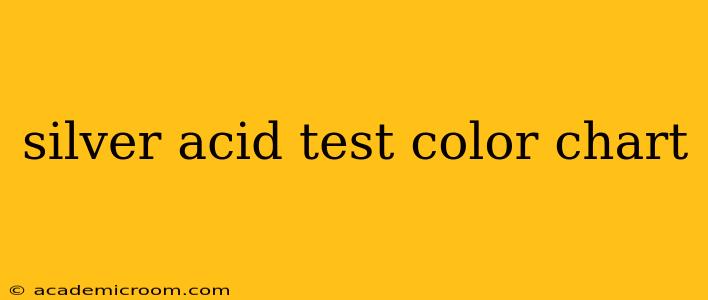The silver acid test, also known as the nitric acid test, is a crucial method for identifying the purity of silver. It involves dissolving a small sample of silver in nitric acid, observing the resulting solution's color to determine the metal's purity. Understanding the color changes is critical for accurate assessment. This guide provides a comprehensive overview of the silver acid test color chart and its interpretations.
What is the Silver Acid Test?
The silver acid test utilizes the reaction between silver and nitric acid (HNO₃). Pure silver (99.9% or higher) will dissolve in nitric acid, producing a clear, colorless solution. Impurities, however, will often lead to different colors in the solution. The color of the resulting solution serves as an indicator of the silver's purity and the presence of other metals.
Interpreting the Colors in the Silver Acid Test
The color chart isn't a precise, standardized scale like a pH chart. The shades are subtle and depend on several factors, including:
- The concentration of nitric acid: Stronger acid may lead to faster reactions and slightly different color hues.
- The amount of impurities: A higher concentration of impurities will result in a more intense color change.
- The type of impurities: Different base metals produce distinct colors when reacting with nitric acid.
However, we can provide a general guide to the colors often observed:
- Clear, Colorless: This indicates a high purity silver sample (typically 99.9% or higher). This is the ideal result.
- Light Green or Yellowish-Green: This usually suggests the presence of small amounts of copper. The shade will be lighter with a lower copper concentration.
- Dark Green or Bluish-Green: This indicates a higher concentration of copper in the silver.
- Milky White: The formation of a milky white precipitate often points towards the presence of lead or other insoluble compounds. This is not a clean reaction and signifies impure silver.
- Brown or Black: This is commonly observed when significant amounts of base metals like zinc or iron are present. The darkness of the color corresponds to the concentration of these base metals.
Why aren't there precise color ranges?
It's important to note that a simple color chart cannot offer a precise quantitative analysis. The visual assessment is subjective and only provides a qualitative indication of purity. For precise measurements, other analytical techniques, such as X-ray fluorescence or atomic absorption spectroscopy, are necessary.
What Happens During the Reaction?
When silver reacts with nitric acid, the following reaction occurs:
3Ag + 4HNO₃ → 3AgNO₃ + NO + 2H₂O
This produces silver nitrate (AgNO₃), nitric oxide (NO), and water. The silver nitrate solution is typically clear and colorless. The presence of other metals changes this reaction and affects the final solution's color.
H2: How accurate is the silver acid test?
The accuracy of the silver acid test is limited. While it's a useful preliminary screening method to assess the general purity of silver, it cannot determine the precise percentage of silver present. Its qualitative nature means it can only offer a general idea of purity based on the observed color changes. For precise quantitative analysis, more sophisticated techniques are required.
H2: What other metals can be identified with a similar acid test?
Acid tests are used for various metals beyond silver. The colors produced vary significantly depending on the metal and the acid used. For example, gold reacts differently with nitric acid than silver does; pure gold will not dissolve in nitric acid. Different acids may also be needed to dissolve and identify other metals. Different color reactions are indicative of different base metals; for example, the presence of copper may create a greenish hue in a nitric acid reaction, while iron produces a brown solution.
H2: What are the safety precautions for conducting a silver acid test?
Nitric acid is a corrosive and potentially dangerous substance. Always conduct this test in a well-ventilated area and wear appropriate personal protective equipment (PPE), including gloves, eye protection, and a lab coat. Dispose of the used acid and solutions properly according to local regulations. Never conduct this test without proper training and safety precautions.
Conclusion
The silver acid test, while simple in its execution, is a valuable tool for initially assessing silver purity. However, remember that it only offers a qualitative assessment based on color observation. For precise analysis, more sophisticated laboratory techniques are necessary. Always prioritize safety when conducting this test.
